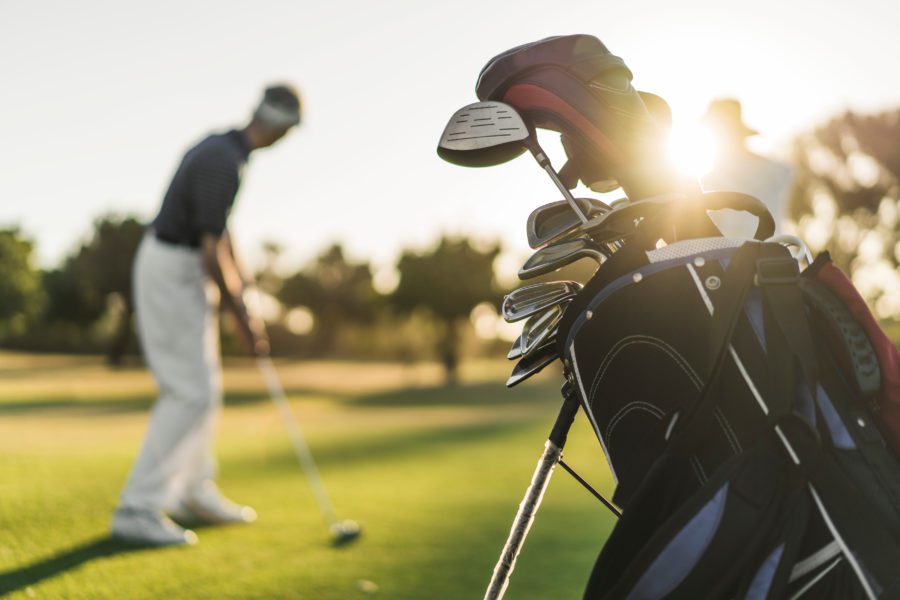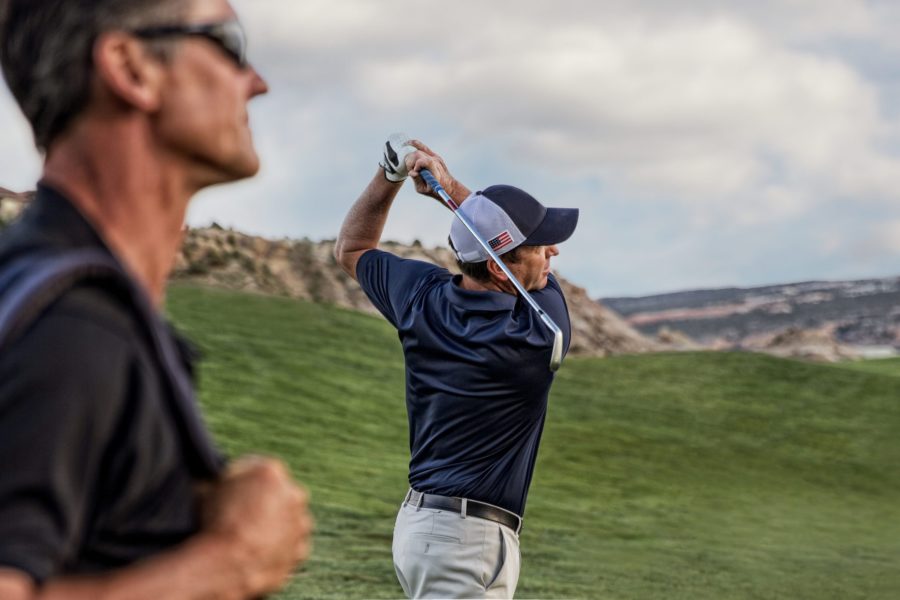There is no shortage of opinions when golfers weigh in on who makes the best golf clubs. One clubhouse sage tells you that Cobra is the best for neophytes, while better players hit Titleist.
Then a different guru says TaylorMade is best for distance, unless you’re a feel player, in which case you want Mizuno or Ping. And that person says you should carry Cleveland wedges and an Odyssey putter. Or just go with that golfer’s take on the best complete golf club set: Callaway.
Graphite shafts or steel shafts? Mallet or blade putter? Are you confused yet? You will be if you don’t apply some logic when choosing your next set of golf clubs.
You can buy what your friend swears by, or you can go with the sponsor of your favorite tour pro, but they won’t be the best clubs for you unless you begin with your body and your swing.
Sharpening your skills will do more to improve your golf game than buying the hot new sticks all the magazines are raving about. Most golfers have heard how young Lee Trevino made money for years by hustling other golfers with a Dr. Pepper bottle.
So yes, golf clubs are less important than golf skills. However, if you’re a mere mortal like most of us, you need to avoid playing with clubs that don’t suit your body or your swing.
If you choose poorly, you won’t get the most out of your skills because you can’t overcome bad habits caused by ill-fitting golf equipment…and you don’t want to change your swing to suit your clubs.
First: Get a custom club fitting
No matter which arrows you prefer, start with a comprehensive evaluation. A custom fitting may start with body measurements, because there is no such thing as an average-sized golfer, even among the pros.
Tadd Fujikawa is 5’1” and Jon Thompson is 6’9”; a difference of 20 inches. We all have a unique stance and swing, and the purpose of a custom fitting is to work with the body you were born with and golf swing you already have.
Where can I get a custom club fitting?
Your club pro or a retailer can set up an appointment for club fitting at a driving range or golf course. Either approach is feasible, as long as the focus is on your swing and the goals you want to achieve.
What happens in a golf club fitting?
Your appointment might start with a question-and-answer session. Where do you feel your game is strong? What changes are you trying to make? What type of shot do you miss most often?
A club fitter may measure your current set of golf clubs to understand the length, loft, lie and swing weights you are working with now. And plenty of time will be devoted to watching you hit with your current set of clubs.
The fitter may also ask you to hit with a variety of other golf clubs, and may measure your speed with a launch monitor. Golf club fitters are not trying to re-engineer your swing. Rather, they want to determine the angle of your club at impact, whether you are centering the strike and many other factors.
Where is your sweet spot?
A strike perfectly centered on the club face, with the club at the optimum angle, will give you the greatest potential for distance and accuracy.
To the extent that you strike the ball toward the crown or sole…you will lose distance. Likewise, a strike toward the heel will tend to slice, or toward the toe will tend to hook.
What is your ideal golf club length?
One basic element of custom fitting is an evaluation of club length. If you are striking shots low on the face and on the toe, a club that is slightly longer can help. Likewise, if you are consistently striking the ball too high on the face and on the heel, the fitter may have you try a club that is shorter.
Are you open or closed at impact?
Another factor that can move your strike off-center is angle of the club face at impact. This is not referring to the loft angle, but rather whether the face is closed or open at impact.
If your face angle is closed at impact, you will tend to strike the ball more toward the toe. If your club angle is open at impact, you will strike the ball more toward the heel.
Would more offset help you close the face?
If you tend to strike the ball with the face more open at impact, a club fitter may recommend more offset, especially with irons. This would not be recommended if you tend to strike with the face more closed, as more offset would increase that tendency.
Would a stiffer profile help you open the face?
Players with a higher swing speed can cause the club shaft to deflect more toward the ball just before impact, which tends to close the face. A golf club fitter may recommend clubs with a stiffer profile to minimize deflection, or a more flexible tip section to add deflection.
Do you need to correct a shaft droop?
Shaft droop is the degree to which the tip section of the shaft bends down at impact, relative to the grip section. Shaft droop can cause the toe to dig at impact. This tendency can be minimized by switching to a shaft with stiffer profile toward the tip section.
What is your club head speed?
In golf, speed is distance. If you can usually drive 200 yards, your speed is 200 divided by 2.3, or about 87MPH. Most weekend golfers launch a golf ball at 80-90MPH, and most tour professionals up to 120MPH.
In a custom fitting, the club fitter may measure your head speed and angle of ascent with a launch monitor. This is a compact doppler radar device that can give the fitter a number of clues about which head, shaft and grip combinations could complement your swing.
Clubs with specific design advantages
Next, we’ll look at new models from some of the best-known brands, many with features that can address the unique swing characteristics that the custom fitter helped you identify.
For the most part, our focus will be on standard and game improvement clubs for golfers with average skills. We will include clubs by Callaway, Cleveland, Cobra, Mizuno, Ping, Srixon, TaylorMade, Titleist and Tour Edge – starting with the design characteristics of their drivers.
Rogue® Drivers by Callaway
The Rogue series features drivers that are designed to add power, fight spin, and accommodate different swings. The Rogue ST Max D is for golfers who need help fighting a slice. Max LS combines swing error forgiveness and lower spin.
Max ST LS is front-weighted for more skillful players, and the ST Max is rear-weighted for stability, considered Callaway’s best option for the rest of us.
Launcher XL® Drivers by Cleveland
The Launcher XL series focuses on size with forgiveness for off-center hits. Launcher XL is adjustable to optimize launch angle. This feature can also be used to dial the face more open or more closed.
Model XL Lite is not adjustable, but that allows a lower center of gravity for higher launch, and the ultralight shaft can up your swing speed. Model XL Lite Draw corrects your slice by providing a more closed face and mis-hit forgiveness.
LTD X® Drivers by Cobra
The LTD X series is big and light, shaped to launch high with maximum forgiveness. Model LTD X combines rear weight with forward mass to lower the center of gravity for less spin.
Model LTD X Max features moveable weights. Moving to the rear adds stability on off-center hits, while moving the weight toward the heel helps keep the face closed to reduce slice.
ST® Drivers by Mizuno
The ST series all feature a weight-saving composite crown and sole, with adjustable weights in heel, toe and center tracks. Model ST-G 220 can add two central back weights for higher stability and launch.
Model ST-Z 220 shifts mass toward the rear perimeter for a deep COG and high forgiveness. The ST-X 220 shifts rear weight toward the heel to fight slice, and the face angle is slightly closed to assist.
G425® Drivers by Ping
The G425 series uses a web of thin ribs on the underside of the crown to reduce thickness. This weight-saving keeps a low center to avoid spin. Model G425 Max provides an eight-way adjustable hosel to add or subtract 1.5 degrees of loft.
Model G425 SFT keeps the adjustable hosel and adds weight to the heel to hit square and launch higher. Model G425 LST adds more weight forward to reduce spin, plus an adjustable 17 gram perimeter weight for stability.
ZX® Drivers by Srixon
The ZX series offers two designs that optimize how the golfer makes impact. Model ZX5 is more forgiving, with adjustable rear weights and higher stability on off-center hits.
Model ZX7 is more exacting, with heel and toe weights to adjust the center of gravity. ZX7also has a 12-way adjustable hosel that allows the golfer to fine-tune both loft and face angle.
Stealth® Drivers by TaylorMade
The Stealth series is both lighter and larger than previous models, because these clubs use carbon composite face, rather than titanium. The standard Stealth model uses the lighter face material to move weight to sole and rear for higher launch and more resistance to twisting on off-center hits.
The Stealth Plus adds a sliding weight in the sole to add weight toward the heel or toe. Steal HD has draw-biased design characteristics that help eliminate slice and add stability.
TS® Drivers by Titleist
The TS series includes four club heads with different characteristics. Model TS11 is the lightest, targeted to players who need more swing speed, while still fighting slice. Model TS12 has a large footprint for high launch and low spin, with a large face for hit forgiveness. Titleist call TS12 its “distance bomber.”
Model TS13 is for the precision player who wants multiple weight adjustments to correct for accuracy. TS13 has five settings to adjust rear, heel and toe weights. Model TS14 has the lowest and most forward COG for long hitters who want to reduce spin during ball flight.
722® Drivers by Tour Edge
The 722 series offers characteristics for both weekend golfers and more highly-skilled players. Model C722 features two weight ports for adjusting the front and back of the sole, allowing accurate hitters to fine-tune their launch and spin.
Model E722 is larger and weighted along the rear for maximum forgiveness when the ball is struck off-center. The E722 also has the highest moment of inertia of any club on the market.
Rogue® Fairway Woods by Callaway
The Rogue series Max model balances stability against a low center, with available lofts from 15 to 27 degrees.
The Max D model is the high launcher, with extra heel-side weighting for golfers who need more correction. Model LS adds more flex in the face profile to make the club more fade-capable.
LTD® Woods by Cobra
The LTDX woods are designed for distance, with a fixed rear weight. Model LTDX Max is weighted in both the rear and the heel to fight slice. Model LTDX LS is optimized for high-skill players can shape shots. Two weights each in the heel and toe allow adjustment for a draw or fade in ball flight.
G425® Fairway Woods by Ping
G425 woods include three models: G425 Max is designed for more forgiveness of mis-hits, with a larger head and more rear-weighting. G425 SFT is sized and weighted to correct your slice, while Model G425 LST is available only in a three-wood, with loft adjustable from 13 to 16 degrees and an adjustable hosel to tweak the face to be more open or closed at impact.
Stealth® Woods by TaylorMade
Stealth makes the best fairway wood for average golfers who can use some help hitting off the grass. A slotted sole adds flexibility to the club face, and a laser-etched topline makes the face angle more visible. The Stealth Plus model uses more composite and titanium so that the face can be larger and more weight can be used for adjustment.
TSi® Woods by Titleist
TSi woods also use a slot in in the forward portion of the sole to make the face more flexible. Model TSi1 is ultralight and features an adjustable hosel for lofts up to 24.5 degrees. Although the club head is lighter than previous models, the COG has moved rearward to boost launch angle.
Model TSi2 is a larger and more forgiving fairway wood for off-center strikes, while Model TSi3 features a sole weight with heel, toe and neutral settings for players who want to shape shots.
Apex® Hybrids by Callaway
Apex hybrids feature an adjustable hosel and a larger head for more forgiveness. The Apex Pro model is for better players, with a heavier shaft and a smaller head for low launch and more spin.
Air-X® Hybrids by Cobra
Air-X is the best hybrid club to help players with a slow swing speed do three things better: (1) generate ball speed to launch high and (2) gain ball flight distance while (3) avoiding slice.
CLK® Hybrids by Mizuno
CLK hybrids feature eight head settings to help players dial in lie and loft that suits their swing. A new face design improves impact at the lower part of the face, where hybrids most often strike a golf ball.
G425® Hybrids by Ping
G425 hybrids wrap a high-strength steel face around the sole and crown to increase distance and reduce spin. Three dots on the top of the crown help align the head perfectly at address.
ZX® Hybrids by Srixon
ZX hybrids have compact heads with a high-strength alloy face for more rebound at impact. A step-down design in the crown lowers the COG for optimal trajectory while reducing spin.
Stealth® Hybrids by TaylorMade
Stealth hybrids offer a standard model featuring a larger head with extra weight in the rear perimeter for more hit forgiveness. Stealth Plus has a more iron-like profile to help better players shape shots.
TS® Hybrids by Titleist
TS hybrids are available in three models. TSi1 helps average players add ball speed and high launch. TSi2 is for players with a sweeping swing. TSi3 has a flat launch and low spin for better players.
Golf Irons for Every Player
There are golf irons for every playing style and skill level. Players golf irons are for better golfers who want to work the ball. Players-distance golf irons are for skilled golfers who want shape shots and retain distance.
For the rest of us, game improvement irons are the most forgiving golf irons, helping us launch high and hit straight, while super game improvement irons are the best irons for beginners or seniors who are willing to give up some workability for more consistent enjoyment of straight shots with golf irons. In this article, we’ll focus on game improvement golf irons.
Note that many of new golf irons are available with steel or graphite shafts, adjustable hosels and other features that can make them the best irons for custom fitting.
Rogue® Game Improvement Golf Irons by Callaway
Rogue irons have moved their COG 50 percent lower for higher launch. A progressive hosel is longer in the long irons and shorter in the short irons, adding weight to rotate the face more easily.
Launcher® Game Improvement Golf Irons by Cleveland
Launcher series employs two head designs in its golf iron set. Long irons use a hollow body design for 4 through 7, and a cavity-back for the 8 through gap wedge. The objective is smoother swings to square the face at impact.
LTDX® Game Improvement Golf Irons by Cobra
LTDX golf irons strive for distance using a steel core bar in a polymer casing. The bar is attached to the heel and toe, but not the hitting area, adding more flex at impact for a rebound effect with a solid strike feel.
JPX Hot Metal® Game Improvement Golf Irons by Mizuno
JPX 921 Hot Metal irons use a chromoly steel single-piece casting to produce club heads that are slim for more ball speed. Mizuno also offers its Shaft Optimizer to match those irons with the right shafts.
G425® Game Improvement Golf Irons by Ping
G425 golf irons use both material and design to increase ball speed. Its new steel alloy is 10 percent stronger for a face with more deflection. An undercut along the top rail with a hinge-like sole for increased ball speed.
ZX4® Game Improvement Golf Irons by Srixon
ZX4 irons combine a stainless-steel body for enhanced feel with a higher-strength steel face insert for striking pop. Material was removed from the sole for more bounce and distance when shots are hit fat.
Stealth® Game Improvement Golf Irons by TaylorMade
Stealth golf irons use a multi-material design that is 7.5 lighter than steel, allowing the face to move freely at impact. The face is easy to square, with variable thickness as slim as 1.6mm to boost ball speed and distance.
T300® Game Improvement Golf Irons by Titleist
T300 irons use a variable-thickness face with a polymer core in the lower sole to enhance flex and feel. T300 also uses 40 percent more tungsten in the toe and heel, increasing forgiveness for off-center hits.
Jaws MD5® and Full Toe Wedges by Callaway
Jaws MD5 features grooves that help more edges grab the ball. The Full Toe version extends the grooves across the face, adding a weight pad in the high toe to raise the COG for more spin.
CBX Zipcore® Wedges by Cleveland
CBX Zipcore wedges have the most prominent tour-style grooves on a game-improvement wedge. A low-density aluminum silicate fills the inner low-heel area, increasing stability for better ball speed, launch and spin.
T22® Wedges by Mizuno
T22 wedges keep their friction grooves sharp and durable by infusing carbon steel with boron. The low lofts have narrow grooves, while the higher lofts have wider grooves to add spin to partial shots.
Glide® Wedges by Ping
Glide wedges mill their low-loft grooves with steeper sidewalls, while higher lofts angle the groove wall to improve partial shots. The club face is grit-blasted with emery to create more friction to impart spin.
Milled Grind® Wedges by TaylorMade
Milled Grind wedges use an un-plated finish on the club face, allowing grooves to be cut closer to the edges. Between each groove, .02mm ribs extend from the surface for more friction to maximize spin.
Vokey® Wedges by Titleist
Vokey SM9 wedges move the COG forward and higher on the club face. This combination minimizes excessive loft for a lower flight with improved launch and spin.
Frontline® Mallet Putters by Cleveland
Frontline putters move the weight forward; the opposite of most other designers. Cleveland contends that most mallet designs cause mis-hits to twist the face open, pushing the ball off-line.
King Vintage® Mallet Putters by Cobra
King Vintage putters use a descending loft pattern on the face, which helps the putt roll straight. Hits that strike upward or downward at impact will launch at an angle encouraging roll.
Eleven® Mallet Putters by Odyssey
Eleven putters use lightweight aluminum and polymers to build the club head, with heavier steel loaded forward for a smooth release. The graphite-steel shaft moves weight closer to the hands for better feel.
Ping® Mallet Putters by Ping
Ping putters apply multi-material designs to render mallet heads with a both responsive and stable, helping golfers improve long or short putts. Tungsten weights add forgiveness for off-center hits.
Spider GT® Mallet Putters by TaylorMade
Spider GT putters combine the high forgiveness of previous models with the feel of a front-loaded putter. Perimeter weights soften off-center hits, and a grooved face insert helps the ball start rolling.
Phantom X® Mallet Putters by Titleist
Phantom X putters combine precision-milled stainless steel with aircraft grade aluminum for a soft, responsive feel, a satisfying sound and plenty of forgiveness for less-than-perfect ball strikes.
King 3D Printed® Blade Putters by Cobra
King 3D Printed putters are assemblies of 11 components, including an intricate lattice within the head, which must be rendered by 3D printing. Tungsten heel and toe weight keep stability on off-center hits.
ER/V® Blade Putters by Evnroll
ER/V putters offer a choice of six hosels, adjustable during your fitting or at any time, to create a toe hang that fits the golfer’s stroke. A unique grooved face keeps heel or toe mis-hits on target.
OMOI® Blade Putters by Mizuno
Omoi putters are heavier in the head, with a shaft and grip that are lighter than typical putters. This results in excellent off-center hit forgiveness, as well as a smooth stroke and a solid feel at impact.
Tri Hot 5K® Blade Putters by Odyssey
Tri Hot 5K putters are something between a blade and a mallet. The multi-material head uses heavy tungsten weights to add stability and shift the center of gravity forward to control side spin.
Ping® Blade Putters by Ping
Ping putters are available in four models, for golfers with strong- or slight-arcing putting strokes. Grooves on the face yield a soft, forgiving impact, but retain the ball speed of a smooth face.
TP Collection Hydroblast® Blade Putters by TaylorMade
Hydroblast putters include the long, narrow Soto model, as well as the stouter Del Monte. Both feature urethane-filled face grooves that give at impact, helping the ball to roll rather than push forward.
Scotty Cameron® Blade Putters by Titleist
Scotty Cameron putters are a classic design based on milled 303 stainless-steel, preferred by many tour players. The new Special Select models feature tungsten heel and toe weights for added forgiveness.
Now Head for the Pro Shop
Hopefully, we have given you some ideas for narrowing down your choices for new golf clubs. Learning about your swing will point you toward the right goals, and trying different clubs will help you find the tools to achieve those goals.
If any of these brief descriptions of golf gear sounded right for your game, take the next step by asking your pro shop to let you try a few swings with the best golf clubs of 2022.







